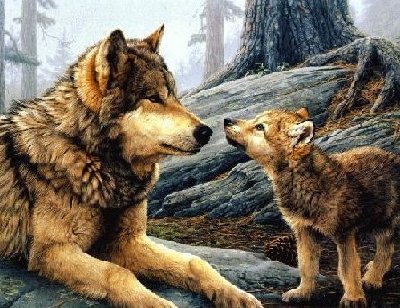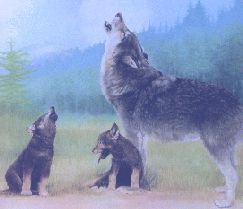|
|
Little Red Riding Hood Lied!
Throughout the ages, the wolf has been depicted as a solitary, fearsome beast that savagely slaughtered every living thing it came upon. Children's fables such as "Little Red Riding Hood", "Peter and the Wolf", and "The Three Little Pigs" perpetuated that fear, as did legends of werewolves. For centuries, up until the twentieth, he was despised, hunted and killed.
Now, just as this magnificent animal is realizing his rightful place as the top predator in the wilds of the Yellowstone National Park, he is in danger of losing his life as well as his new home. Citing illegal activities by the United States Fish and Wildlife Service, the American Farm Bureau Federation is going to great lengths to have the wolves removed. Truly, if the courts decide in their favor, it will be a travesty of justice and will obliterate the most successful recovery program in the history of the United States.
The wolf is a family oriented creature, existing in a sophisticated hierarchical society. He mates for life, is shy of humans, and kills only for food or self-preservation. The allegation that wolves are dangerous to humans is a myth. "There is no documented case of a healthy wolf killing a human in North America" (Mech 1995). As is the human species, he is very nurturing and patient with his young, but a harsh disciplinarian when the need arises. The alpha male and female, as the strongest and most intelligent, are the only pack members to breed, thus ensuring the perpetuation of the healthiest gene pool.
The early settlers perceived the wolf as a menace to both people and livestock and by the 1890's, bounties were paid for the pelts. In 1915, the federal government hired hunters and trappers to extirpate all wolves in the lower forty-eight states. In the spring of 1924, their task was completed in the Yellowstone area when they pulled two cubs from their den and destroyed them. By the early 1930's the extermination was complete (Maughan 1997).

In 1973, Congress enacted the Endangered Species Act, mandating recovery for endangered and threatened species. The gray wolf was so listed. Before long, the U. S. Fish and Wildlife Service began assembling the Northern Rocky Mountain Wolf Recovery Team, under the watchful eye of the Department of the Interior. By 1984, the National Wildlife Federation was involved and passed, with the approval of its western affiliates, a joint resolution supporting the reintroduction.
It was time to start educating the public and armed with an arsenal of information, they proceeded. Countless meetings were held with groups and people who remained skeptical. Pat Tucker, a wildlife biologist hired by the National Wildlife Federation, coordinated this enormous effort. With patience and candor, they DID manage to convince some of the critics that reintroduction would be beneficial to the health of the ecosystem, pose no threat to humans, and cause little difference in the big game populations. In addition, they were reassured that the reintroduced wolves would be designated "non-essential and experimental", which means one would be allowed more flexibility in dealing with problem wolves, as opposed to naturally occurring wolves which could not be touched under the Endangered Species Act.
Early in 1990, Defenders of Wildlife set aside a $100,000 Wolf Compensation Trust, funded wholly by private donations, to offset any losses of livestock by the ranchers. This went a long way to pacify many of the locals. However, not everyone was happy; the American Farm Bureau Federation entered into the conflict, along with such entities as the Sierra Club and the Audubon Society. Claiming to represent the area farmers and ranchers, the Farm Bureau was striving to suppress the reintroduction by alleging that the Fish and Wildlife Service would be breaking the law by introducing captured animals into an area that already supports natural wolves.
The Department of the Interior and the Fish and Wildlife Service, in late 1994, established a set of federal regulations pertaining to the "non-essential, experimental" population of gray wolves in Yellowstone Park, Idaho and Montana. It included "approval by the Fish and Wildlife Service to harass any wolf on public or private lands in an opportunistic and non-injurious manner". In other words, area owners may chase off wolves that come too close. These same landowners and producers may kill a wolf if caught in the act of taking livestock. To avoid prosecution, they must report the incident. In addition, all reintroduced wolves will be removed from the wild and the status revoked if:
- legal actions change the status to endangered OR
- naturally occurring wolves, paired and raising offspring, are discovered in the experimental population
Despite all the obstacles and as these final rules for the management of the reintroduced wolves were being released, wildlife experts were in Alberta, Canada, preparing for the capture of wolves. Three days later, the American Farm Bureau filed suit claiming irreparable damage to ranchers. Early in January 1996, several conservation groups filed an additional lawsuit alleging that the plan doesn't sufficiently protect the wolves.
By this time, 14 wolves were being held in acclimation pens in northern Yellowstone, awaiting release in March. Optimistically, using this "soft release" (as opposed to transport and immediate release) method would prevent the pack from migrating back into Canada (TimeLine 1997).
In late 1995, the case against the Fish and Wildlife Service was assigned to William Downes, Federal District Judge for the Wyoming District Court. Eventually, all plaintiffs united and the fight was joined. Little did anyone know just how long and difficult that battle would be. In the meantime, everyone was watching the wolves and, miraculously, they were thriving and problems were few.

- AFB:Charges that the Fish and Wildlife Service knew of existing wolves in the area at the time the reintroduction went into effect.
- FWS:Maintains no suppression on their part and that there were no wolves present at the time of release. FWS acknowledges that an occasional wolf may migrate into the area, but that doesn't constitute "breeding pairs."
- AFB:Claims that the reintroduction was carried out "in spite of two pending lawsuits and the knowledge of possible illegalities."
- FWS:Judge Downes denied a request by the Farm Bureau for an injunction to halt the program.
- AFB:Claiming concern for the weakened protection of the reintroduced wolves, they want them removed.
- FWS:The Bureau's position seems to be "no wolves" not "more protection." It is ironic that they don't understand that with the recovered wolves gone, the natural migration of wolves will soon become evident and will come under the very strictest rules of the Endangered Species Act. Even now, the Farm Bureau's claim is that farmers and ranchers are subject to too many restrictions.
- AFB:Maintains that the reintroduction has not been beneficial to the environment or man and has, in fact, been detrimental to farmers and ranchers.
- FWS:The wolf has stabilized the ecosystem by controlling the small vermin that plague the landowners and regulated the coyote that predates upon livestock. He is regarded as a key species; his removal would cascade clear to the grasses (Kluger 1997). Of course, the wolf will eat cows and sheep; however, "given the choice, the wolf prefers wild meat to that of a domesticated animal" (Kent Weber 1998). The almost 30% decrease in the coyote population has benefited smaller hunters such as owls, raptors and martens that no longer have to compete with them over prey. Endangered grizzlies, too, have profited as, on occasion, they take over wolf kills. The most visible and distinct effect of their presence is the reduced number of elk, whose population exploded after the eradication of the wolf early in the century. The elk, unchecked, caused extreme damage, including the destruction of old-growth aspen and the exclusion of other ungulates.
- AFB:Most people oppose wolf restoration.
- FWS:In a poll taken by the National Wildlife Federation, it was found that 76% support the wolf; in the event they are ordered destroyed, the favorable poll reached 86%. "I find ranchers all over the country who understand wildlife and appreciate it. They tell me about wolves they've had around their ranches and what they were like. It's the politics that is hurting these animals more than anything" (Weber 1998).
- AFB: Wolves will eliminate prey species.
- FWS: Food availability and weather regulate the wolf population: hard times bring about fewer and smaller litters and cull all but the strongest. In addition, there are approximately thirty-five to forty thousand elk in the greater Yellowstone area. To maintaon a stable elk population, 25% of the calves born each spring must survive. Since 1995, the percentage has ranged from 24%-34%, concluding that the wolves have not decimated the herds.
- AFB: The local economy in the Northern Rockies is based on livestock production.
- FWS: It was found that only 4% of personal income was related to livestock production.
- AFB: Wolf recovery will preclude other land uses.
- FWS: Very few restrictions have been necessary and only the illegal mortality of the wolves would cause this to change (EnviroAction Newsletter 1998).
America was stunned when, on December 11, 1997, Judge Downes issued his opinion. In order to protect the native wolf population, which the Fish and Wildlife service maintained did not exist, all reintroduced animals in Wyoming, Montana and Idaho must be removed. He stated the "experimental population rule" violated the Endangered Species Act. However, he stayed his order pending an expected appeal based on "breeding populations" definition.
Defenders of Wildlife, the National Wildlife Federation and others appealed the order, emphasizing that there is no place for the wolves to go; it would mean a death sentence for them. The American Farm Bureau and Judge Downes have denied they want the wolves destroyed, just moved. In spite of Secretary of the Interior Bruce Babbitt's statement to a congressional committee informing them that Canada will not take the wolves back, a sub-committee of the Farm Bureau passed a resolution calling for the return of the animals to Canada.
In a letter to the National Wildlife Federation, Sidney Butler, Executive Director of the American Zoological Association states, "On behalf of the 184 accredited members of the AZA, I wish to advise you that placement of these wolves in zoos is not a viable option." Ed bangs, representing the Fish and Wildlife Service, followed with an official statement that the wolves would have to be destroyed.

The critics of wolf reintroduction may well live to regret their first round victory in court. Judge Downes' order, if upheld, would precipitate an act of carnage. Canada doesn't want the animals, confinement is hardly an option and the zoos simply don't have room. "Wolves from Canada and northern Montana will migrate south and, enjoying the full protection of the ESA, kill whatever and whenever they wish(Askins, 1998)."
"We will challenge this decision all the way to the Supreme Court if necessary. It would be a tragedy to dismantle the greatest wildlife restoration effort in our nation's history. It defies common sense (Schlickeisen, President of Defenders of Wildlife 1998)."
"We exterminated the wolf once; we're not going to do it again. The American people will not stand for it (Tom Dougherty, NWF April 1998)."
Interior Secretary Bruce Babbitt announced at the NWF's annual conference, "No wolves will be removed on my watch."
From an American Farm Bureau member, "I am currently a Farm Bureau member in Oklahoma County. Drop this case about the wolves in Yellowstone. The Farm Bureau should be concerned with the rebuilding of our environment for the posterity of our country and our world (Mauldin 1998)."
Tom McDonnell, a representative of the Wool Growers Association addressed a U. S. Senate sub-committee in May of 1995. He adamantly maintained that wolf predation is high and that the wolf population in Canada and Alaska shows that they are not in any danger of extinction.
Rob Edwards, for Defenders, refutes this by his statement. "The future of the wolves of Canada and Alaska is by no means secure. Habitate destruction and organized campaigns to exterminate northern wolf populations continue to push them toward extinction."
Reactions to wolves vary immensely among different types of people. Politicians and business people are scared to death of them, students admire them, and ranchers are wary but respectful. Inner-city kids view them as attack/guard dogs, enviromentalists want to cuddle them and reporters want to 'sell' them. "We are frustrated when articles and television programs, featuring our work, glorify the unusual or sensational aspects and fail to provide a clear understanding of the situation as a whole (Tracy Brooks Mission:Wolf 1997)."
The Defenders of Wildlife has released some statistics: to date, $71,876 has been paid to area ranchers and farmers from the Wolf Compensation Trust for livestock lost to the wolves. Total livestock taken include 99 cattle, 198 sheep and 56 other.
Let's ask some questions:
- How dangerous is the wolf, really?
- Which group seems to care more about the over-all environment?
- Who, if anyone, seems to have a secret agenda?
- What about the statistics of livestock taken?
- Is the wolf essential as a vital part of the ecosystem?
- What conditions have improved since the reintroduction?
My verdict is firmly established on what I perceive to be the facts. The environment becomes healthier with each passing year and these magnificent animals are at last home where they belong.
If you still aren't convinced that the wolves should stay in the Yellowstone area, meet, talk with and learn from Kent Weber and his dedicated staff at Mission:Wolf, one of several groups that play such an important part in wild-wolf recovery. Make friends with Sila and Merlin, the wolf ambassadors, and watch as they interact with each other and their caretakers. Marvel at their strength and intelligence. Absorb the wolf song as they bid you welcome; listen with your heart. It will stir your soul.
 For Beautiful Art Work! For Beautiful Art Work!

"Since only the sun and moon made light, I have known you. I watched you from the once vast impenetrable forest. I was witness as you discovered fire and strange tools. From ridges, I watched you hunt, and envied your kills. I have eaten your scraps. You have eaten mine.
I have heard your songs and watched your dancing shadows around bright fires. In a time so distant that I can barely remember, some of us joined you to sit near those fires. We became part of your packs, joined in your hunts, protected your pups, helped you, feared you, loved you."
Excerpt from Jim Brandenburg's book, "Brother Wolf"
Thank You!

 Please visit Jim Brandenburg's site Please visit Jim Brandenburg's site
 Home Home
 The Wolves Win! The Wolves Win!
 Now for Something Different! Now for Something Different!
 If you're a 'blues' enthusiast, go to "Given Permission!" (my kids) If you're a 'blues' enthusiast, go to "Given Permission!" (my kids)
 E-MAIL ME E-MAIL ME
This page is copyrighted © 2000
Pages by "snowshoe"
Dated April, 15th, 2000
|